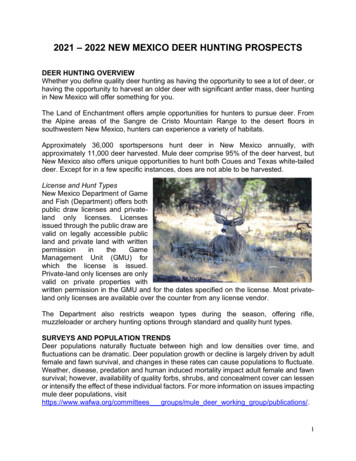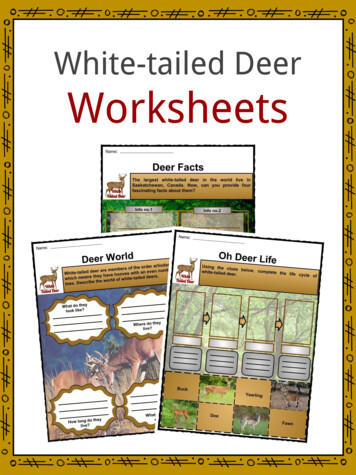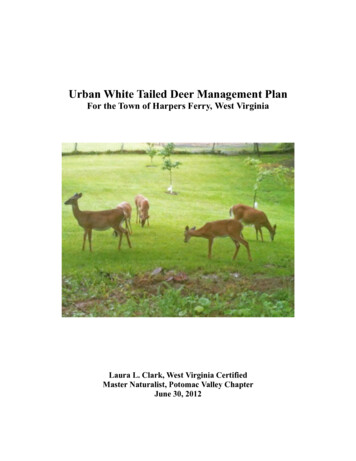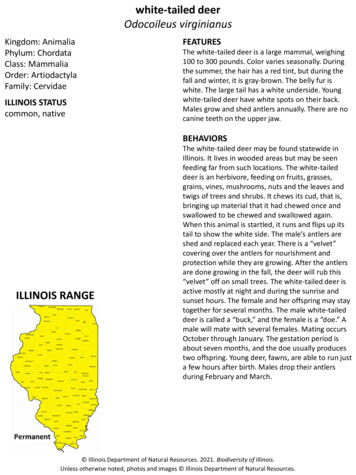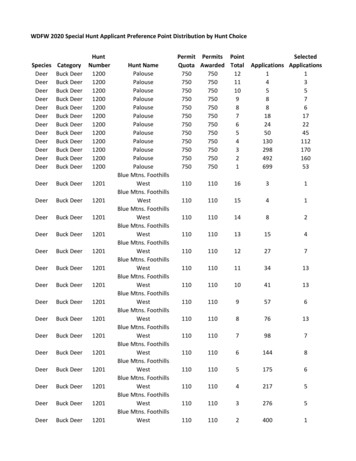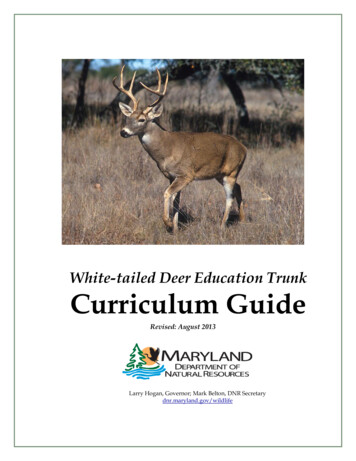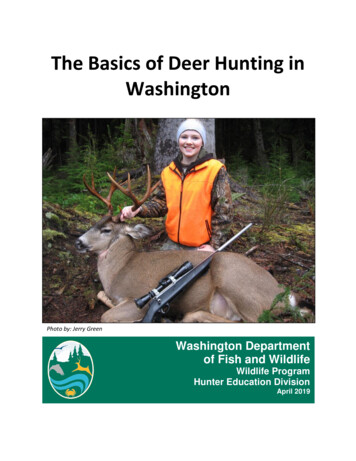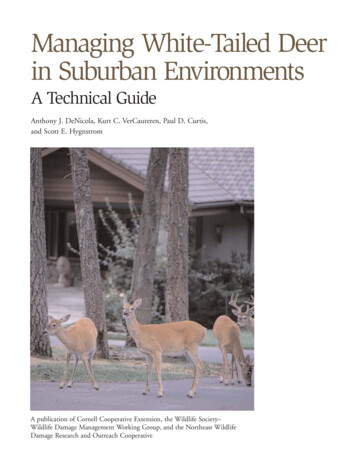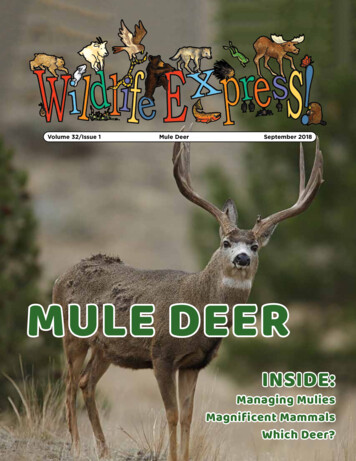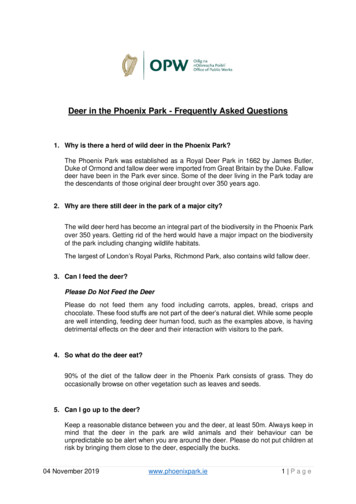
Transcription
MARYLAND WHITE-TAILED DEER MANAGEMENT PLAN2020–2034
EXECUTIVE SUMMARYWhite-tailed deer (Odocoileus virginianus) are one of Maryland’s most recognizable wildlife species.Wildlife-watchers, photographers and hunters contribute millions of dollars each year to the state’seconomy while pursuing deer, but, unfortunately, deer are also responsible for millions of dollars indamages annually to automobiles, agriculture, landscaping and young forests. The Maryland Departmentof Natural Resources (DNR) is charged with managing white-tailed deer in a way that balances theinterests of those who support hunting as a management strategy and those who suffer economic lossfrom deer against the interests of outdoor enthusiasts who enjoy experiencing deer in the wild. Findingcommon ground and sustainable population goals that reasonably satisfy all stakeholders is a challengingand complex process. In response to this need, the department created the first deer management plan in1998 to help guide deer management. The plan was revised in 2009; this document represents the secondrevision and will guide deer management through 2034.White-tailed deer were plentiful in Maryland at the time of settlement in the 1600s, but at density levelsmuch lower than those observed today in most parts of the state. Market-hunting and habitat loss nearlyextirpated deer from the state by 1900. The early 1900s through the 1960s was a period of populationrestoration and deer proliferated due to ideal habitat conditions and the protection of female deer fromharvest. By the 1980s, management philosophies across much of the state changed from restoring deer tostabilizing and reducing deer numbers.Active management of deer is a necessity today to maintain population levels that are compatible with thevaried interests of the citizenry of the state. As an evolutionary prey species, deer exhibit a high fecundityrate, enabling them to rapidly increase in number. Presently, non-lethal management techniques (such ascontraceptives and sterilization) and non-hunting mortality (disease, injuries and predators) are notsufficient to maintain deer populations at satisfactory levels. Lethal control of deer via regulated huntingremains the most effective way to balance the deer population with environmental and cultural concernson a landscape scale. However, lethal control of deer is not always feasible in the densely populated urbanareas of the state. As a result, the Maryland deer plan addresses non-lethal deer management concepts andpromotes their investigation and use to complement hunting and other lethal strategies so that thedepartment may implement a full suite of management options statewide.Along with addressing the use of lethal and non-lethal management, the deer plan documents the historyof white-tailed deer and management in Maryland. It describes the current population status of whitetailed deer and hunters in the state and covers the positive and negative impacts of deer. Finally, the plandocuments the responsibilities of the deer management program and outlines five major goals(Population, Education, Recreation, Damage and Operational Resources) and the underlying strategiesand objectives for achieving those goals.The deer plan is intended to represent the interests of all residents and nonresident stakeholders who havean interest in Maryland’s deer population. Therefore, the plan, like previous renditions, was created withextensive input from the public. Outreach efforts included a 40-member stakeholder group who helpedguide revision of the plan. The department also worked with the University of Delaware and ResponsiveManagement, Inc., a professional public opinion survey firm, to conduct an extensive public opiniontelephone survey. Lastly, public comments were accepted at four public meetings, as well as from letters,email, the internet and phone calls. The 2020–2034 Maryland Deer Management Plan will provide thefoundation for all deer management activities and decisions for the coming 15 years.2
CONTENTSINTRODUCTIONPurpose of the Maryland White-tailed Deer Management PlanPlan History and DevelopmentStakeholder Group MeetingsPublic Meetings and CommentsPublic Opinion SurveyStatus of the 2009 Plan’s Goals, Objectives, and StrategiesPopulation GoalEducation GoalRecreation GoalDamage GoalOperational Resources GoalAcknowledgements777781010111212HISTORY OF WHITE-TAILED DEER AND THEIR MANAGEMENT IN MARYLANDColonial EraModern EraExcessive DeerCreation of the 1998 Maryland White-tailed Deer PlanCooperation Among Management EntitiesAlternative Management Tools131315151617CURRENT STATUS OF WHITE-TAILED DEER AND WHITE-TAILED DEERHUNTERS IN MARYLANDWhite-tailed Deer Population StatusWhite-tailed Deer Hunter Population Status1822RELATIONSHIP BETWEEN WHITE-TAILED DEER AND HUMANSPositive Impacts of White-tailed DeerNegative Impacts of White-tailed DeerLyme Disease and White-tailed DeerBiological and Cultural Carrying Capacities24252626MARYLAND WHITE-TAILED DEER MANAGEMENT PROGRAMWhite-tailed Deer Population RegulationWhite-tailed Deer HarvestWhite-tailed Deer Harvest RegulationsDeer Management PermitsDeer CooperatorsLetters of AuthorityManaged HuntsWhite-tailed Deer Fertility Control StudiesVenison Donation ProgramsWhite-tailed Deer Population MonitoringMandatory Deer Harvest Check-in36273030323232333535
Biological Data Collection (Butcher Shop Surveys)Deer Population ModelingAnnual Hunter Mail SurveyAnnual Archery Hunter SurveyFLIR SurveysHunter Pressure SurveysScientific Research StudiesDisease SurveillanceWinter Mortality SurveysWildlife ResponseInformation and EducationAddressing Constituent DemandsProvide Recreational Deer OpportunitiesReduce Deer Crop DamageReduce Deer-vehicle CollisionsReduce Urban/Suburban Deer ConflictsContinue to Investigate Non-lethal Deer Control MethodsOther Management ActivitiesCaptive DeerFawn RehabilitationShooter Qualification ProgramGOALS, OBJECTIVES AND STRATEGIESPopulation GoalEducation GoalRecreation GoalDamage GoalOperational Resources 55LIST OF FIGURESFigure 1. Estimated statewide white-tailed deer population, 1988–2018Figure 2. Maryland deer management regions, 2018Figure 3. Estimated Region A white-tailed deer population (excluding all of WashingtonCounty), 1988–2018Figure 4. Estimated Region B white-tailed deer population (including all of WashingtonCounty), 1988–2018Figure 5. Maryland hunting license sales, 1940–2018Figure 6. Maryland white-tailed deer harvest, 1927–2018Figure 7. Maryland white-tailed deer harvest (%) by season, 1994–2018Figure 8. Maryland Deer Management Permit (DMP) deer harvest, 1990–20181920212223282931LIST OF APPENDICESAppendix 1. White-tailed deer biologyAppendix 2. 2020–2034 White-tailed Deer Management Plan stakeholder groupparticipants45658
Appendix 3. Maryland Residents’, Landowners’, and Hunters’ Attitudes Toward DeerHunting and Deer Management, Executive SummaryAppendix 4. Deer management options and their advantages and disadvantagesAppendix 5. Common white-tailed deer diseases and ailmentsAppendix 6. Summary of public comments regarding the draft 2020–2034 MarylandWhite-tailed Deer Management Plan598487LITERATURE CITED92591
INTRODUCTIONWhite-tailed deer (Odocoileus virginianus) remain one of the most recognizable and well-knownwildlife species in Maryland. They are admired by wildlife watchers who enjoy theirgracefulness and by hunters who enjoy their wariness. At the same time, they negatively impactthe economic livelihood of Maryland farmers, arborists, motorists, and general citizenry.Although white-tailed deer represent the preeminent example of bringing a species back from thebrink of extinction, their continual over-abundance in many areas have posed decades-longthreats to natural forest ecosystems and to other wildlife species.Divergent opinions and interests concerning white-tailed deer present significant managementchallenges to the Maryland Department of Natural Resources (‘DNR’ or ‘the department’), thestate agency responsible for managing Maryland’s wildlife. Establishing deer population goals tosatisfy a myriad of constituents and finding a balance between lethal and non-lethal deer controlmethods remain two of the many challenging aspects of managing deer in Maryland today. This15-year plan documents the goals and objectives put in place in previous plans to address theseissues and many others related to managing this charismatic species in Maryland.Purpose of the Maryland White-tailed Deer Management PlanThe Maryland White-tailed Deer Management Plan (‘the deer plan’) documents the history ofwhite-tailed deer and white-tailed deer management in Maryland (information on basic whitetailed deer biology can be found in Appendix 1). It also describes the current status of whitetailed deer in Maryland and the positive and negative impacts of the species. Finally, the plandocuments the responsibilities of the department’s deer management program (i.e., deer project)and other department staff as they relate to white-tailed deer management, and outlines the goalsand objectives for Maryland white-tailed deer management through 2034. It is important to notethat this plan is a strategic plan and not an operational plan that identifies specific managementdetails. Management details, such as changes to hunting seasons and bag limits, are addressedbiennially by the department through regulatory changes and include their ownpublic/stakeholder input process.Plan History and DevelopmentMaryland’s 10-year white-tailed deer management plan was instituted in 1998, and revised forthe first time in 2009. The plan was originally created in response to growing conflicts betweenhumans and deer in many parts of the state. Unfortunately, many of those conflicts that existed in1998 and 2009 still exist today and much of the plan has remained relevant since its inception.With the second revision of the deer plan set to expire in 2018, the review process for the thirdrevision of the plan began in 2017. Like the previous versions, the department incorporatedstakeholder and public input into the current revision. Comments, suggestions and opinions werecollected from stakeholder meetings and four public meetings, as well as telephone, internet,email and mail communications (over 850 public comments were received). Likewise, a publicopinion survey of 2,200 Maryland residents (800 from the general public, 800 deer hunters and600 landowners) was conducted, in cooperation with the University of Delaware and ResponsiveManagement, Inc. to solicit opinions on current deer management issues. Finally, expert opinionsfrom department staff were vital in crafting the final plan.6
Stakeholder Group Meetings–The stakeholder group was comprised of individuals representing27 different deer special-interest groups across Maryland. Representation included: animalwelfare, equestrian, farming, forestry, government (county, state, federal), native plantprotection, outdoor recreation, sportsmen, and university. Members of the DNRWildlifeAdvisory Commission were also stakeholders. A list of the interest groups can be found inAppendix 2. Stakeholders were convened for three meetings. At the first two meetings they aidedin identifying major deer management issues that needed to be addressed in the plan andidentified areas of the previous plan that could be modified. At the third and final meeting, theywere given the opportunity to comment on a final draft of the plan that was provided to themprior to the meeting.Public Meetings and Comments–Four public meetings were held across the state in 2019 toobtain public feedback concerning deer and deer management. Attendance ranged from 27people in La Plata to 75 people in Owings Mills (34 people attended in Wye Mills and 35 peopleattended in Frostburg). Attendees were given a short presentation regarding the status of deer andmanagement in Maryland, and then given the opportunity to provide comments/suggestions atwork stations manned by department staff. Each station represented a deer managementcategory, and attendees could visit each station to provide comments. Stations included thefollowing categories: (1) Deer Population Management, (2) Suburban/Urban Deer Management,(3) Deer Hunting Seasons and Bag Limits, (4) Deer Diseases and Other Topics. The departmentreceived over 850 comments via the public meetings, internet, email, telephone and mailregarding deer and deer management in the state. Urban/suburban deer issues and agriculturaldamage from deer were common complaints.Public Opinion Survey–Like previous iterations of the deer plan, the department contracted tohave a professional public opinion telephone survey completed. The University of Delaware, inconjunction with Responsive Management, Inc., conducted the survey in 2018 (ResponsiveManagement 2018). This survey provided needed information about public perception regardingdeer and management in Maryland, and how it may be changing over time. A total of 2,200Maryland residents (800 from the general public, 800 deer hunters and 600 landowners) weresurveyed. The allocation of surveys mirrored the process used for the 1998 and 2009 plans andpermitted comparison of results between the surveys. Sampling from the three major groupsensured the opinions of all Marylanders were equally represented. Responsive Management alsoprovided additional analysis of the general public group by separating the hunters from the nonhunters to identify differences in opinions regarding deer management for these groups. Overall,opinions regarding deer and deer management have not changed appreciably over the past 20years in Maryland. The Executive Summary from the survey is available in Appendix 3. Theentire report is available online at the department website.Status of the 2009 Plan’s Goals, Objectives, and StrategiesMaryland’s 2009 deer management plan built on the plan before it and contained five broad,long-term goals: Population Goal: Use diverse and progressive methods to ensure the long-term viabilityof Maryland’s white-tailed deer population through comprehensive research, efficientmonitoring, public outreach, trained staff and effective management;7
Education Goal: Educate Maryland citizens on all aspects of deer biology, includingmanagement tools, disease issues, economic aspects and recreational opportunities; Recreation Goal: Provide the opportunity for all citizens to safely, fairly and ethicallyenjoy diverse deer-related recreational experiences and traditions consistent withestablished deer population trend goals; Damage Goal: Identify and actively address the negative impacts the deer population hason human interests and the ecosystem in a manner consistent with the long-term viabilityof the deer population in Maryland; and Operational Resources Goal: Ensure that all necessary resources are available to supportthe proper management of white-tailed deer in Maryland.These goals effectively addressed the diverse requirements of managing deer in Maryland andthey remain largely unchanged for the 2020–2034 plan. Likewise, most of the goals’ identifiedobjectives and strategies in the previous plan are still relevant and included in this plan. In thatway, this plan can and should be viewed as a continuation of the previous plan, with updateswhere needed.During the past 10 years the department has implemented or continued with most of theobjectives and strategies identified in the previous deer plan. A brief synopsis of major activitiesunder each goal follows:Population Goal–For the population goal, the department largely continued with aggressive deerpopulation control methods for much of the state in order to stabilize and reduce the populationduring 2009-2018. Lethal harvest via regulated hunting remains the most effective method formanaging deer. The department also continued the Deer Management Permit (DMP) system,primarily for agricultural producers experiencing deer damage, and the Deer Cooperator Permit(DCP), which authorizes sharp-shooting deer in problem areas. The deer cooperator permit wasexpanded to include agricultural areas, enabling permitted farmers to shoot deer at night toreduce crop damage. Also during the last 10 years, numerous public properties were acquiredand opened for deer hunting to help control deer numbers.Along with providing ample opportunities to harvest deer, the department continued focusingharvest on antlerless deer. Seasons and bag limits remained structured to prioritize femaleharvest, and outreach materials, including press releases and web information, stressed theimportance of antlerless harvest to help maintain deer numbers. The antlerless portion of theannual harvest remained at 60% or above for the duration of the plan period.To monitor the population status, the deer project began using antlered harvest per square mile asone metric and continued using an overall annual population estimate generated with a modifiedreconstruction model (Lang and Wood 1976; Downing 1980). Mandatory deer check-in,implemented in 1927, has remained a foundational block for being able to use these trend metricsto monitor the deer population. During the past 10 years, the electronic hunting license and deercheck-in system was modified so each hunter, including landowners, is assigned a permanent8
identification number. This change greatly improved the accuracy and efficiency of theelectronic check-in system for monitoring the deer harvest.To date, the deer project has not established county-specific deer population trend goals; doingso continues to remain challenging due to significantly varying opinions on how deer should bemanaged and at what population densities. The department continues to use both biological andcultural inputs when making management decisions about the deer population. However, thedeer project will continue to investigate implementing county trend goals.During the past 10 years the department has also continued to support and investigate non-lethaldeer management techniques. This has primarily involved research projects aimed at limitingfertility in female deer. Some of these studies date back to the creation of the first deer plan in1998. The department approved the use of one U.S. Environmental Protection Agency-certifieddeer contraceptive (GonaCon) for management purposes, but it has never been used in the state.Instead, in recent years, the focus has shifted from birth control using contraceptives to, instead,permanently sterilizing female deer. The department has cooperated on several sterilizationresearch projects and will continue to cooperate on non-lethal deer management research ingeneral.The deer project also continued monitoring the effects of known deer diseases in the state.Epizootic hemorrhagic disease occurs annually and, in some years, can cause significantmortality in localized areas. However, deer populations rebound quickly. The department alsomonitored the incidences of brain abscesses in deer, which are reported less frequently. The deerproject cooperates with various universities and institutions that study and monitor deer disease.Unfortunately, it was during the span of the last deer plan that chronic wasting disease (CWD)was discovered in Maryland. The disease was detected in West Virginia near Allegany County in2005, and then found in Maryland in 2010. The department randomly tests 500-1,000 hunterharvested deer for the disease annually, primarily in Allegany and Washington counties where itis presently found. Additional information on CWD is presented later in the plan.The deer project also continued with its successful urban/suburban deer management program.Staff met with numerous homeowner associations and county/local governments to provideeducation and support concerning proper deer management techniques. Outreach materials(handouts, website material, presentations, etc.) were developed and revised as needed to explaineffective urban deer management.The advent of social media during the past 10 years enabled the department to increase outreachto its constituents. Many facets of deer management and deer biology were promoted usingpopular social media platforms and the department webpage. Likewise, constituents continued toutilize the customer service portal to email questions and comments at their convenience. Thedeer project regularly issued press releases concerning upcoming deer hunting seasons, harvestresults, disease testing results, and other deer management related issues. Staff also routinelywrote popular articles for various magazines and gave oral presentations and seminars related toMaryland deer management.9
Lastly, during the past 10 years the department experienced stable staffing levels related to deermanagement. While some institutional knowledge was lost due to retirements, positions weretypically backfilled quickly and with qualified individuals. Likewise, training and certificationswere routinely conducted to ensure staff were properly prepared.Education Goal–Outreach and education regarding deer and deer management remained a focusfor the duration of the 2009 plan. Staff routinely met with all facets of the public about deer,including hunters, landowners, homeowners, government officials, public land managers,students, and members of the general public. The department’s main message promoted theimportance and value of deer along with the need for management due to the significant negativeimpacts they have on some constituents and the environment. Staff routinely discussed theimportance of regulated hunting for managing deer numbers (specifically antlerless deer huntingand the value of quality deer management principles), along with the need for non-lethalmanagement in some instances. Deer management topics were addressed using the departmentwebpage, social media, press releases, other print articles, and direct conversations viaPowerpoint presentations, telephone, email, and letters.Recreation Goal–The popularity and overall recreational value of deer remained a primaryconsideration when making deer management decisions during the 2009 plan period. Deer areone of Maryland’s most popular wildlife species and are enjoyed by many residents and visitors.Nearly 25% of Maryland residents reported in a 2018 survey that they frequently or occasionallymade trips to specifically observe or photograph deer (Responsive Management 2018). Likewise,based on a hunter mail survey conducted each year by the department, hunters spent a total of750,000 or more days annually pursuing deer during that period and deer hunters contributed inexcess of 220 million annually to the Maryland economy via hunting gear, trips, and associatedrevenue (Southwick Associates 2012).Unfortunately, in recent years, the number of days of deer hunting has dropped below the plan’sgoal minimum of 800,000 days per year. Numerous factors contribute to the decline in days,including fewer deer hunters in the population and reduced effort by remaining hunters due totime conflicts and other factors. Opportunities to hunt deer generally have not decreased due toseason and bag limit changes or other actions by the department. The goal will remain to achieve800,000 days per year for the coming years.Various changes were made to hunting laws and regulations during the past 10 years to enhancethe recreational aspect of deer hunting, which indirectly supported the population and damagegoals, and the need to further reduce deer numbers in many areas. During this period, thedepartment regularly supported legislative changes that added Sunday hunting opportunities,which greatly increased the amount of time many hunters had to deer hunt. An ApprenticeLicense was created to recruit new hunters in Maryland. The Apprentice License made it easierto obtain a first hunting license, without sacrificing adequate safety standards. Also, restrictionson the use of crossbows and air-powered weapons were eased during the past 10 years to recruithunters and offer additional recreational opportunities. Likewise, in some counties, the archerysafety zone was reduced from 150 yards to 50 or 100 yards to provide additional access for deerhunting. Regulations were also adopted to allow daylight fluorescent pink safety clothing to beworn in place of daylight fluorescent orange clothing. Optional colors for safety clothing maymake deer hunting more attractive to some individuals, aiding with hunter recruitment.10
Deer hunting remains a safe, fair, and ethical recreational activity in Maryland, and thedepartment has strived to maintain that status. During the past 10 years, the department hasworked with Natural Resources Police to increase opportunities for potential new hunters to takehunter safety classes in order to get their first hunting license. Staff also continued oversight ofthe shooter qualification program that enables hunters to satisfy the requirement ofdemonstrating their shooting proficiency in order to participate in managed deer hunts. Lastly,the department supported legislation to significantly increase penalties for deer poaching andcreated a wanton waste regulation that requires hunters to make a reasonable attempt to retrieveand make use of any deer that they wound or kill.Damage Goal–While it is a primary goal of the department to ensure adequate recreationalopportunities associated with white-tailed deer remain available for constituents, the departmentis equally charged with ensuring deer numbers are managed at levels that minimize the negativeimpacts that deer can have. Finding a balance between having enough deer to satisfy recreationaldemands, but not too many that they cause significant economic and environmental damage, isone of the most challenging tasks the department is responsible for. During the past 10 years, thedepartment has observed a decline in the estimated deer population from approximately 250,000deer down to about 200,000 deer. In many rural areas of the state, deer numbers are noticeablylower than they were at their peak, but damage complaints are still commonplace, particularlyfrom the farming community. Likewise, in urban and suburban areas where deer hunting islimited, deer numbers remain too high and residents experience significant damage to theirproperties. The department’s goal will remain to minimize all deer damage to the extent possible.Deer-vehicle collisions, crop damage, and urban/suburban damage (landscaping and yarddamage) are the most common complaints the department receives about deer. During the past10 years, the number of deer-vehicle collisions reported has remained stable (State FarmInsurance, pers. comm.), which, when accounting for the increase in total miles driven during thesame time period, suggests that collision rates may have been reduced to some extent. However,collisions with deer still remain a significant issue and the department will continue toinvestigate methods to reduce them.Along with deer-vehicle collisions, the department continued to address urban/suburban deercomplaints, crop damage issues, and damage to natural habitats. Unfortunately, these complaintsbecame even more commonplace during the duration of the last deer plan. Numerousinstructional presentations were given to urban/suburban communities suffering with overabundant deer, and staff participated with various working groups and workshops addressingurban deer issues. Staff also continued issuing deer management permits to farmers that allowedyear-round harvest of deer, and conducted multiple workshops with the farming community toaddress deer damage. Deer hunting seasons and bag limits remained very liberal throughout thestate, and state-owned properties were opened for deer hunting when possible. Staff alsoidentified deer threats to natural habitats, including rare, threatened, and endangered species, andresponded accordingly with non-lethal techniques, including fencing, and lethal techniques todirectly reduce deer numbers in the affected areas.The department also continued licensing Deer Cooperators (i.e., deer sharp-shooters) andexpanded the program to include agricultural properties. Due to changes in state law, the periodfor removing deer under a deer cooperator permit was reduced to February-March in all cases,11
except those involving human safety (airports, military test tracks, etc.). The department alsocontinued issuing letters of authority to lethally remove deer from airports and other facilitieswhere deer posed a significant human safety risk. However, these letters were rolled into theDeer Cooperator Permit process at the end of the last deer plan.Lastly, the department closely monitored for any deer-related diseases, including CWD andLyme disease, in order to provide accurate and reliable information to constituents. This includedannually sampling hunter harvested deer for CWD and establishing a management area for thedisease. Staff also cooperated on several tick research projects during the plan duration. Selectstaff were properly equipped to rapidly respond to wildlife emergencies, many of which involveddeer, to minimize risks to public health.Operational Resources Goal–During the last 10 years the department remained adequatelystaffed and equipped to manage deer. However, the number of hunters in the state continued todecline, negatively impacting the department’s primary revenue source (the sale of huntinglicenses). Efforts have been made to maximize the acquisition of federal monies available fromthe Federal Aid in Wildlife Restoration Act (“Pittman-Robertson Act”), but declining licensesales places limits on these funds as well.To counter the decline in hunters, staff were hired specifically to work on hunter recruitment,retention, and reactivation (R3), including an initiative which has been launched departmentwide. Outreach and education staff have invested significant e
White-tailed deer were plentiful in Maryland at the time of settlement in the 1600s, but at density levels much lower than those observed today in most parts of the state. Market-hunting and habitat loss nearly extirpated deer from the state by 1900. The early 1900s through the 1960s was a period of population
